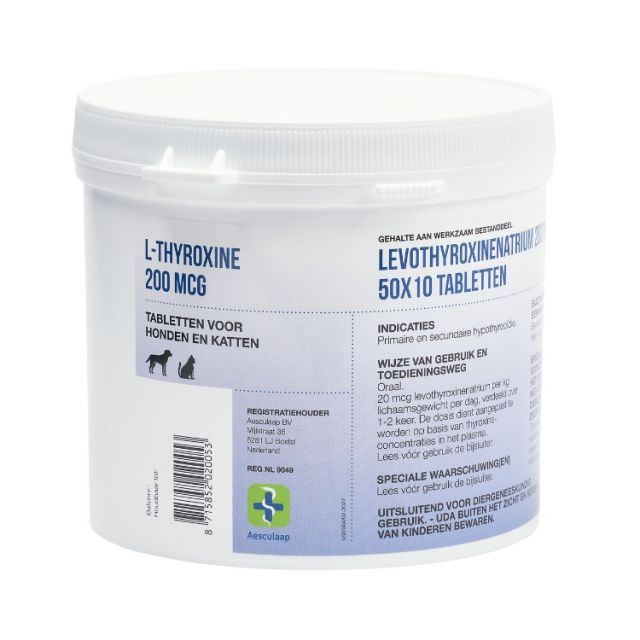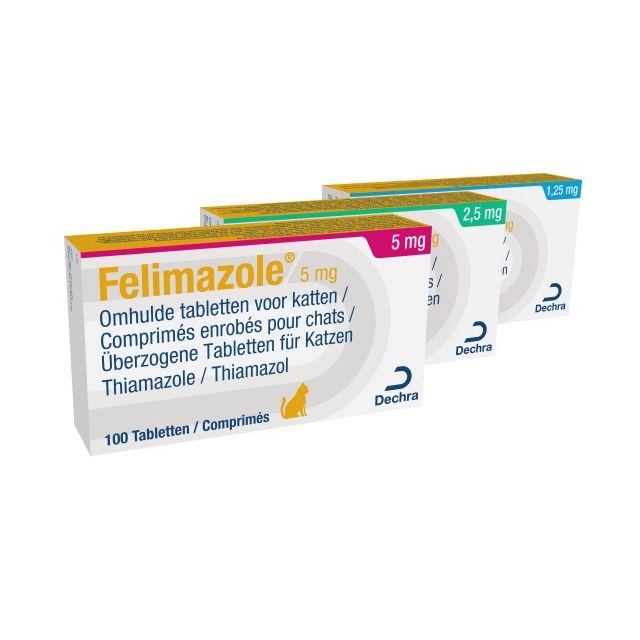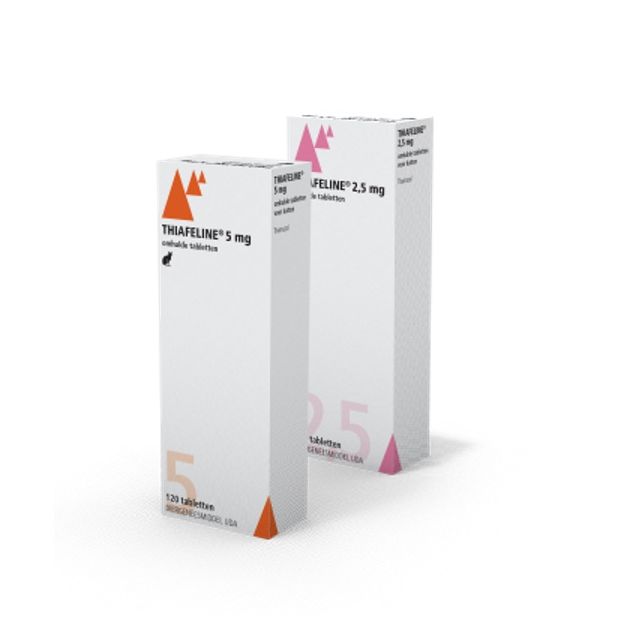The thyroid gland of the cat
A hyperactive thyroid, or hyperthyroidism, often occurs in older cats. A slow-working thyroid is rarely seen in cats, unlike in dogs, where hypothyroidism, a thyroid that works too slowly, is much more common. Fortunately, a hyperactive thyroid is almost always treatable. Pharmacy4pets helps you recognize thyroid problems in your cat and supports your cat with hyperthyroidism with prescription thyroid medication.
The cat's thyroid gland
The cat's thyroid consists of two small glands located on the left and right sides of the windpipe in the cat's neck. The thyroid glands produce thyroid hormones. These hormones are very important for metabolism, and an excess (or deficiency) of them affects many other organs. Most cats with thyroid problems have hyperthyroidism: a too quickly working or overactive thyroid. The thyroid produces too many hormones. Hypothyroidism, or a slow-working thyroid, is rare in cats.
Hyperthyroidism in cats
In cats with a hyperactive thyroid, the thyroid gland is enlarged. Hyperthyroidism mainly occurs in older cats, averaging twelve years of age. When the thyroid works too quickly, the cat's metabolism, the metabolism of the cat, is accelerated. In 70% of cases, both thyroid glands of a cat with hyperthyroidism are enlarged. In 30% of cases, the condition is unilateral.
Symptoms of hyperthyroidism in cats
Due to the accelerated metabolism, cats with a hyperactive thyroid are almost always very restless and easily irritated. They are extremely hungry but still lose weight, even if they eat more than usual. They often drink and urinate more and have more bowel movements. Sometimes vomiting and/or diarrhea are noticeable. In a later stage, they will lie down more quickly because they have largely lost their muscles. Because the heart of cats with thyroid problems works so hard, heart failure can occur and cause difficulty breathing.
Diagnosing hyperthyroidism in cats
The veterinarian will often suspect a hyperactive thyroid based on the symptoms and clinical presentation of the cat (thin, poorly muscled, high heart rate). The enlarged thyroid is also often palpable. The diagnosis will be confirmed with blood tests: the level of thyroid hormone (thyroxine or T4) is elevated in cats with hyperthyroidism. It's usually also advised to measure blood pressure. High blood pressure, hypertension, occurs regularly in cats with hyperthyroidism and can lead to blindness, a brain hemorrhage, kidney failure, and heart problems.
Treating hyperthyroidism in cats
There are four different treatment options for cats with a hyperactive thyroid. The best option depends on the age and clinical condition of the cat and the owner's capabilities. Each option is briefly discussed.
Medication for a hyperactive thyroid
The symptoms of a hyperactive thyroid are usually well controlled with medication that inhibits the production of thyroid hormone. This medication is available as a tablet, liquid, and ear ointment and must be given twice daily for life. About a month after starting the medication, the dosage must be checked and possibly adjusted through blood tests.
Radioactive iodine
In this treatment, the cat receives an injection of radioactive iodine. This substance kills all abnormal cells of the thyroid but leaves the normal cells alive. Due to the radioactivity, the cat must stay in the clinic for a few days after treatment. If there are pregnant women or small children at home, even longer. After treatment, most cats no longer need medication. In some cases, the thyroid works too slowly (hypothyroidism) after treatment, and thyroid hormones must be given.
Iodine-free diet
Without iodine, the cat cannot produce thyroid hormone. If a cat gets very little iodine through its diet, the thyroid function may normalize. The cat must, of course, like the food and may not eat anything else besides this food. Therefore, the option to normalize thyroid function with diet is not suitable for cats that go outside and for very picky eaters. Also, in a multi-cat household where the cats cannot be fed separately, this food is not a good choice. The food is not suitable for healthy cats.
Thyroid surgery
The enlarged thyroid gland(s) can be surgically removed. Before the surgery, a scan must first show whether the thyroid is enlarged unilaterally or bilaterally and if there is possibly additional thyroid tissue in the chest cavity. The parathyroid glands are located next to the thyroid glands and must not be damaged. If the parathyroid glands are damaged, the cat can suffer from a life-threatening low calcium level. Regrowth of thyroid tissue is possible.
A hyperactive thyroid, along with chronic kidney disease and diabetes, is one of the most common 'old age ailments' in cats. Untreated, the cat will die from the consequences of accelerated metabolism, but fortunately, hyperthyroidism is almost always very treatable. If you have a question about our products or about your cat's thyroid, please contact us.





